Games PC MASTER OF ORION II-BATTLE AT ANTARES User Manual
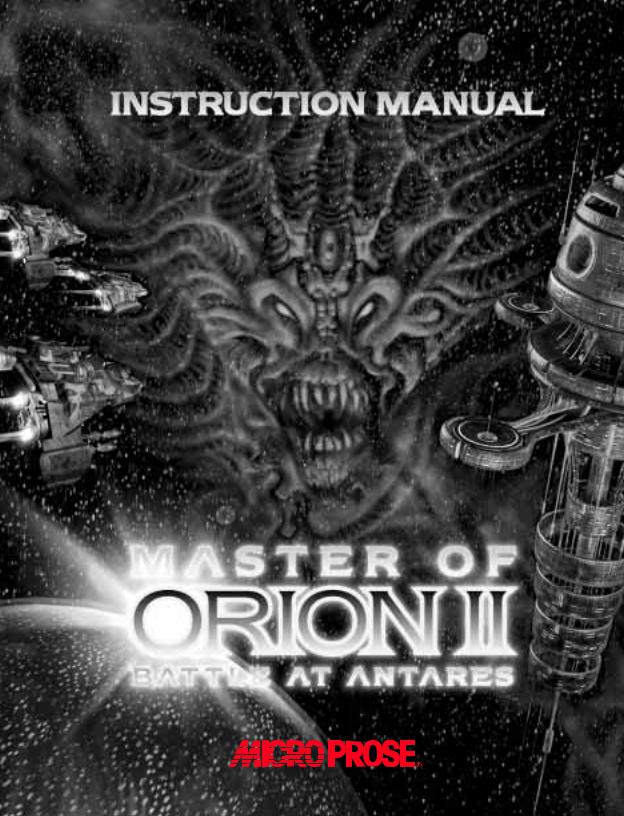

Introduction
ORIONS AND ANTARANS
(Excerpted from ÒPre-Psilonic Galactic CivilizationsÓ Vol. II, by Ectron Victor, retired Master Adjudicator, Psilon Central History Institute.)
As a story is told and retold over the course of generations, no matter the attention paid to detail and no matter the importance of the tale, the truth is gradually nibbled away by little mistakes and innocent exaggerations.
Carried off on these well-intentioned, tiny feet, the facts deteriorate softly and painlessly into a condition generally referred to as Òshrouded by time.Ó
The legends concerning the Orions and Antarans are shrouded by time.
What is certain is that at one time both races coexisted in the galaxy. The scope of their power and technical advancement has surely been enhanced by hyperbole, but that they were far superior to anything now known is indisputable. Perhaps it was inevitable that two such behemoths meet in violence. The legends paint the Antarans as ruthless, xenophobic killers, but we all know that history is written by the victors.
The Orion-Antaran war was a protracted holocaust of galactic proportions. While we can never know if they truly flung entire star systems across deep space as weapons (as the storytellers claim), our astrophysicists have uncovered evidence of directed energy bursts the power of which staggers the imagination. That both races had the ability to raze planets no one contests. The Orions eventually defeated the Antarans. Rather than exterminating the race, as the stories claim the Antarans would certainly have done, the Orions chose to imprison their enemies in a Òpocket dimensionÓÑa volume the size of a single star system, formed and carved somehow out of the fabric of space-time. Physicists to this day puzzle over the theory and the technique, but the result was obvious; the Antarans were banished one and all from
this dimension.
At this point, even the storytellers admit that the legends become vague. Some time after the war, the Orion race inexplicably disappeared. They left only two legacies for the galaxyÕs future inhabitants. One was the tales of their power and legends of the Antaran war; the other is the Orion system itself. One planet circles this star, and it is reputed to be the original home world of the Orion race. Despite the incredible potential this abandoned world must hold, no one has yet plundered or colonized it. The reason for this is that the system is only uninhabited, not undefended. The Orions left a single Guardian to protect their home. Perhaps they intend to return some day.
Perhaps the Antarans intend to return, too.
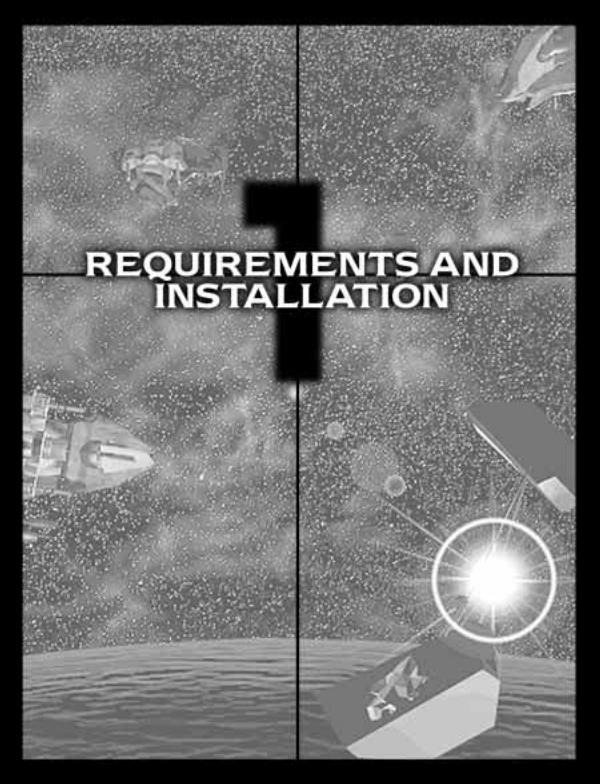
1. Requirements and Installation
YouÕve got the box open, the CD-ROM in your sweaty palm, and a manic gleam in your eyes. What do you do now?
THE TECHNICAL STUFF
For Master of Orion II to work, there are a few things your computer must have.
•The processor has to be a 80486 or better. Basically, any computer with Ò486Ó, or ÒPentiumÓ in its name should do just fine. The system speed should be at least 100 MHz (megahertz). We recommend a 90 MHz Pentium or faster computer.
•You must have a double-speed CD-ROM drive.
•Your computer must have at least 16 MB (megabytes) of RAM (random access memory) installed. (This is the working memory; do not confuse it with the MB of storage space on your hard drive.)
•You must have Windows 95 or Windows 98 installed and running on your computer.
•Since the installation program will copy parts of Master of Orion II onto your hard drive, you must have sufficient storage space on your hard drive. To find out whether you have enough space in Windows, doubleclick on the My Computer icon. Change the View setting to Details, and the amount of empty space on your hard drive (usually drive ÔCÕ) is listed under Free Space.
Important Note: With the advent of larger hard drives, a peculiar problem has arisen. Different sizes of hard drives have different sized ÒclustersÓ (the smallest unit of file space that the drive can read and write).
Without getting into too much technical detail, the result is this: The larger your hard drive, the more space each file takes up. To prevent misunderstandings, weÕve prepared the following chart of necessary free space (in megabytes) vs. hard drive size for Master of Orion II:
iiiiiiiiiiiiiiiiiiiiiiiiiiiiiiiiiiiiiiiiiiiiiiiiiiiiiiiiiiiiiiiiiiiiiiiiiiiiiiiiiiiiiiiiiiii
Disk Size |
0Ð128 MB |
256Ð512 MB |
512 MbÐ1 GB |
1Ð2 GB |
2Ð4 GB |
Space Required |
74.5 |
74.5 |
75 |
76.5 |
79 |
iiiiiiiiiiiiiiiiiiiiiiiiiiiiiiiiiiiiiiiiiiiiiiiiiiiiiiiiiiiiiiiiiiiiiiiiiiiiiiiiiiiiiiiiiiii
•The graphics must be Super VGA quality (640 x 480 x 256 colors) or better.
•A Sound Blaster or compatible sound card is supported.
If you think you have all of these, but still have a problem running the game, please contact MicroProse Customer Support for assistance.
Master of Orion II requires the following for multiplayer:
•Null-modem serial cable (2 players); or
•Windows-compatible 9600 baud modem or faster; or
•Local area network (LAN) supporting IPX protocol
INSTALLING THE GAME
Before you can play Master of Orion II, the installation program must copy some files onto your hard drive. To have it do so, follow these instructions:
•Turn on your computer and let Windows start.
•Open your CD-ROM drive, place the Master of Orion II disc in there, and close the drive.
•Master of Orion II is a Windows AutoPlay CD-ROM. That means that if you are running Windows, just putting the CD-ROM in the drive for the first time starts up the installation program.
•After youÕve watched the introduction, youÕre left looking at the Main menu.
•Click on Install to continue.
•The only decision you need to make during the installation process is to what directory you want to install the game. When youÕre prompted, you can accept the default (c:\mps\orion2), type in a directory path, or use the Browse button to seek out a directory. Click OK when youÕre done.
and Requirements .1 Installation
1. Requirements and Installation
ONCE YOUÕVE MADE ALL THE NECESSARY DECISIONS:
•Master of Orion II will now copy some files to your hard drive from the CD-ROM.
•After the game itself has been copied over, Master of Orion II installs a few necessary utility programs. These include MicrosoftÕs DirectX drivers. The space these take up is included in the total noted above.
•When the installation program is done, you are returned to the Main menu (in Windows 95) or the command prompt (in DOS).
TO START PLAYING THE GAME IMMEDIATELY:
•Leave the Master of Orion II disc in the CD-ROM drive.
•Click on Play Game.
TO PLAY LATER:
•Make sure that the Master of Orion II CD-ROM is in its drive.
•Open the Start menu, then open the SimTex sub-menu, then click the
Master of Orion II option.
Have fun!
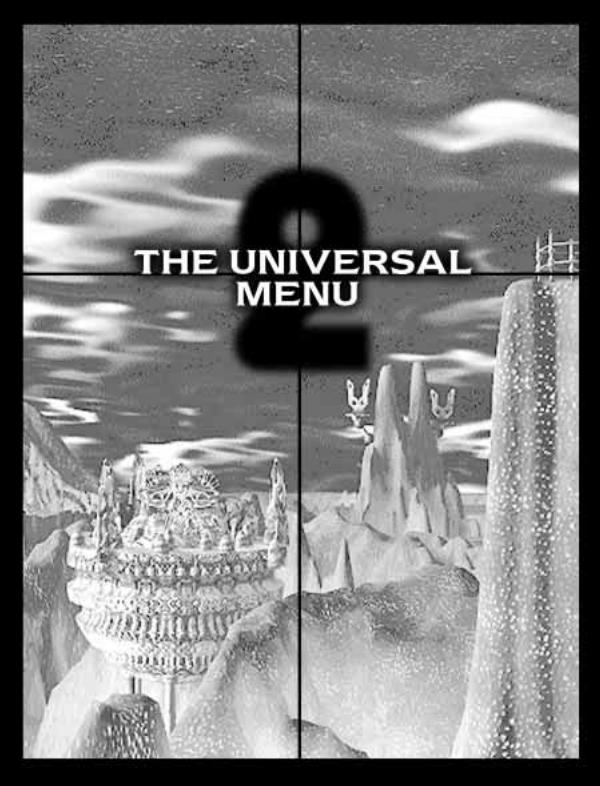

2. The Universal Menu
Whenever you start Master of Orion II, the Universal Menu arcs into view on the right. (YouÕll also notice the game credits scrolling up the screen to the left.) To select one of the options from this menu, move the mouse pointer to that optionÑyouÕll know youÕre in the right place when the option is highlightedÑand click. These options are pretty straightforward:
•Continue restarts the last game you were playing, but not necessarily exactly where you left off. Master of Orion IIÕs ÒautosaveÓ feature periodically saves the game for you. When you choose to continue a game, you begin at the point when the game was last autosaved. This could be as many as 4 turns earlier than the point at which you stopped playing.
•Load Game allows you to return to a game you saved previously. YouÕre presented with a list of all the games youÕve saved. Just click to select the game you want to load.
•New Game generates a fresh galaxy for you to explore. Once you click this option, the Game Setup screen appears. The next section, Beginning a New Game, steps you through the setup process.
•Multiplayer takes you to the Multiplayer Setup screen. This is where you get ready to play against human opponents. For the lowdown, read
Multiplayer Galaxies.
•
•
Hall of Fame presents the best scores of previous emperors.
Quit Game leaves Master of Orion II and returns you to your operating system. You get one chance to change your mind.
Now letÕs take a look at setting up your first new game.
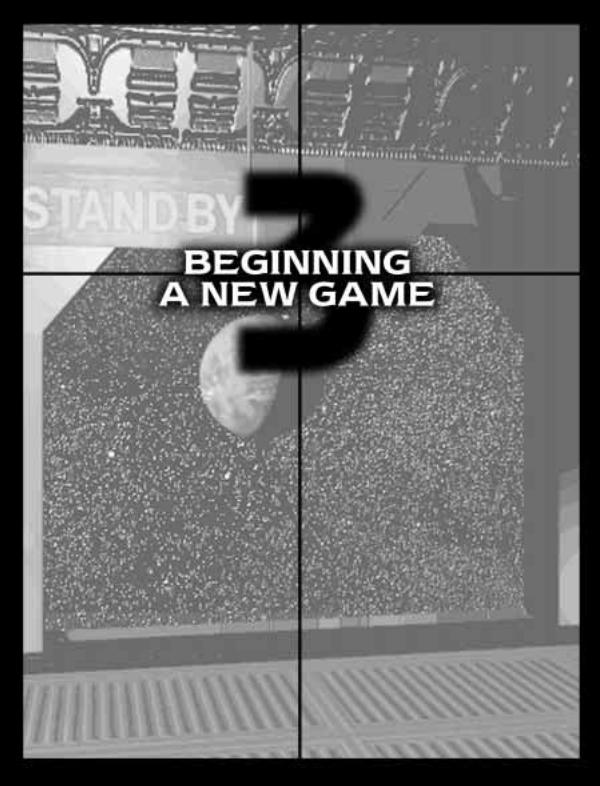
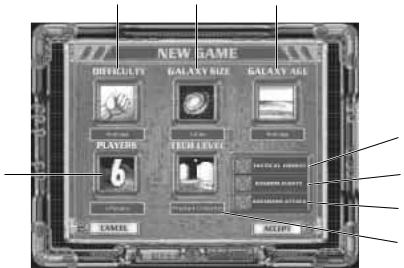
3. Beginning a New Game
Before you can actually start building your empire and rampaging around the galaxy, there are a few decisions you need to make. The overall tenets of the galaxy must meet with your approval, and you need to choose which of the several races you want to rule.
GALACTIC SETUP
DIFFICULTY |
SIZE |
AGE |
|
COMBAT |
|
TYPE |
NUMBER OF |
RANDOM |
RACES |
EVENTS |
|
ANTARAN |
|
ATTACKS |
|
TECH |
|
LEVEL |
|
CONFIGURING YOUR GALAXY |
|
When you start a new game, youÕre taken to the Game Setup screen. Here, |
|
you must make the Eight Serious Decisions. Five of these are represented |
|
by icons, three by buttons. You can click on any of the icons to cycle |
|
through the possible choices for that galactic setting. The buttons are |
|
simple toggles; when each is turned on, itÕs highlighted. (Thus, if itÕs dark, |
|
then itÕs turned off.) |
|
When youÕre happy with the settings, click the Accept button to go on to |
|
select the race you wish to rule. If you decide youÕd rather quit this |
|
process and return to the Universal Menu, click the Cancel button. |
pppppppppppppppppppppp
Difficulty Master of Orion II has five different difficulty settings. Click on the icon to cycle through to the one you feel capable of facing.
Tutor is best for the new player who wants to become familiar with the game. Enemy races wonÕt put up too much of a fight. The only drawback to this difficulty setting is that you arenÕt allowed to create a custom race.
Easy is only slightly more challenging than Tutor. The other racesÕ production and research proceed more slowly than yours, and any of them you encounter are significantly more friendly than it is realistic to expect. As with the easiest mode, you cannot create and use a custom race in Easy mode.
Average difficulty is exactly what it sounds like. All the racesÕ developments proceed at normal rates, including yours. If you feel youÕre familiar with the basics of the gameÑincluding espionage and diplomacyÑyouÕre ready for this difficulty.
Hard is the setting for those who want a challenge. YouÕd better know what youÕre doing.
Impossible is reserved for those of you who enjoy fighting your way out from under a disadvantage. The other races operate with significantly accelerated research and production, and none of them are friendly. In fact, they all hate you right from the start.
pppppppppppppppppppppp
Galaxy Size Galaxies come in all shapes and sizes, but for the sake of simplicity, in Master of Orion II theyÕre boiled down to four classifications. As with difficulty, click on the icon to cycle through to the galaxy size you feel comfortable with. (Note that the number of stars mentioned is approximate, as the term ÒstarsÓ includes black holes and some other phenomena.)
A Small galaxy is little more than a star cluster. This little, 20-star neighborhood guarantees early contact with other races and a fastpaced gameÑnot to mention fierce competition for the limited space and resources.
Medium galaxies include only 36 star systems. Conflict is neither as quick to begin nor quite as ferocious as in a Small cluster. With luck, you have time to develop a few advanced technologies before running into your neighbors.
Game New a Beginning .3
3. Beginning a New Game
Large galactic neighborhoods give you some elbowroom. The planets available in 54 systems allow for expansion and fleet building in preparation for eventual contact with other races. The research possibilities are better, too, but colony management becomes more important in larger empires.
In Huge galaxies, you have the time and space to conduct epic campaigns and pit massive, technologically advanced empires against one another over a span of 72 stellar systems.
pppppppppppppppppppppp
Galaxy Age Regardless of their size, most galaxies age in similar ways.
Young galaxies are nurseries for the development of hot, new stars. These clusters consist primarily of blue and white stars that have only recently blown off the remnants of the stellar nebula from which they formed. If these newborn stars have any planets at all, they tend to be mineral rich, but nearly uninhabitable.
Galaxies of Average age have had time to mature. Overly energetic young stars have settled down into the main sequence, allowing the occasional planet that is amenable to life. Orange and yellow primaries have appeared, along with the rare red helium burner. Mineral-rich planets are still around, but theyÕre less abundant.
Old galaxies have run riot with orange and red grandfathers, well layered and on their way to final burnout. Planets where life can take hold are plentiful, though minerals are not. An explorer might find an ancient white dwarf with a few rocky planets or a rare star in second childhood after a partial nova, but rich mining opportunities are otherwise not extant.
Click on the icon to cycle through to the type of galaxy you prefer to explore.
pppppppppppppppppppppp
Starting
Civilization Manipulating the level of technology with which every empire begins is another way Master of Orion II provides for extra challenges. Click on the icon to cycle through to the level of advancement at which you want
to start.
Pre-Warp is for those of you who like to start at the beginning. Every race has one colonyÑtheir home star system. Exploring outside that system is impossible until faster than light (FTL) technologies are discovered.
Average Civilization starts each race with the same single colony, but with all the technologies necessary for interstellar flight already achieved (plus a few random extras). Every empire has a small star fleet, including one Colony Ship capable of settling a planet.
Finally, Advanced Civilization is for those who want to get right into the thick of it. Much of the galaxy is already explored and settled. Each race begins with several technological advancements in hand and a substantial fleet of ships capable of interstellar travel.
pppppppppppppppppppppp
Number of
Players The number of races you go up against is also under your control. You can choose any number of players from 2 (you and one opponent) through 8 (seven vs. you). Choosing fewer players, naturally, allows more time for developing colonies, technology, and fleets before you make first contact. Having more players sets up a galaxy destined for lots of action and conflict over relatively scarcer resources.
Click on the icon to cycle through to the number of races you want involved in your game.
pppppppppppppppppppppp
Tactical Combat Of the three buttons on the Game Setup screen, the top is the Tactical Combat toggle. When this button is on (highlighted), all combat in the game is tactical. If this is off (dark), all combat takes place under the strategic rules. What does that mean?
ÒStrategicÓ combat means that Master of Orion II takes care of the fighting for you. This is the mode to use if youÕre interested in playing a strategy game without the distraction of designing ships and participating in ship-to-ship combat. In strategic combat games, ship designs are automatic, and battles are decided statistically.
ÒTacticalÓ combat gives you a more detailed game experience. You can design and redesign each of your classes of ship, based on the available technology, as often as you like. In fact, you must design ships in order to have effective fleets. When one of your fleets joins in battle, you personally control the movements, weapons, and special systems of every ship under your flag. This is the mode for a Òhands-onÓ general.
For more detail regarding both these combat modes, read the
Combat section.
pppppppppppppppppppppp
Random Events The middle button controls whether random events, both helpful and hurtful, occur during the game. If you leave random events active, the Galactic News Network will sometimes report an unusual circumstance. Any race in the game could be the target of each event, and some events affect all races.
pppppppppppppppppppppp
Antaran Attacks The bottom button toggles the existence of the mysterious Antarans. When this is off, you can rest easy; the Antarans will not actively seek to attack the colonies of any race in the game. On the other hand, leaving this toggled on can seriously spice up the game, as this powerful race will certainly meddle destructively in galactic affairs.
Game New a Beginning .3
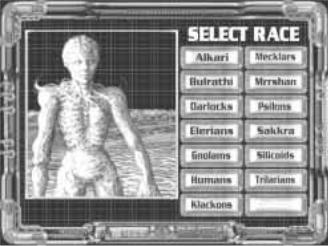
RACE SELECTION
3. Beginning a New Game
CHOOSING A RACE
Once you finish setting up the galaxy, the Race Selection screen appears. Here, you select which of the several available races will make up the population of your empire.
Moving the cursor over the name of a race brings up a picture of an average individual of that race. Any special abilities, advantages, and disadvantages that race has are listed with the portrait. WeÕve also included a brief description of each race here. When you find the one you would like to play, click on the name.
If youÕd prefer to create your own, customized race, click on Custom instead of one of the predesigned races. You are immediately prompted to choose one of the other races; this is simply to select an appearance for your new race. Once you have chosen a portrait, you need to define the racial characteristics. How you do so is detailed below, under Custom.
After you have chosen a race (and finished defining it, if you chose to create a custom race), you have a chance to name yourself. If the suggested name suits you, just click the Accept button or press E. If not, type in a name you prefer first. Next, you must choose the color of your flag. This color is used to denote systems you control, your ships and colonies, and that sort of thing. Just click on the flag of the color you like.
The advantages and disadvantages of each form of government are discussed under Custom.

pppppppppppppppppppppp
Alkari The Alkari are an avian race descended from great flying reptiles. Reared as fliers, Alkari pilots have an almost instinctive grasp of the dynamics of three-dimensional motion. As a result, Alkari ships gain a 40% defensive bonus in space combat. Long ago, the Alkari home world was once a colony of the powerful Orion empire. The ancient artifacts left from that time give their researchers an advantage. The Alkari government is a Dictatorship.
pppppppppppppppppppppp
Bulrathi A large, bear-like people, the Bulrathi possess tremendous strength and hardiness. They evolved on a high gravity (High-G) home world, and thus are able to colonize High-G and Normal-G planets without penalties. The Bulrathi enjoy a 10% bonus in ground combat and a +20 to the Ship Attack of all their ships. Their government is a Dictatorship.
pppppppppppppppppppppp
Darloks A race almost as enigmatic as the ancient Antarans, the Darloks are shape-shifters who can assume almost any humanoid form. As a result, Darlok spies are 20% more likely to be successful on any mission. Their early research has run along lines parallel to their evolution, and so Darlok pilots have the ability to render their ships invisible to long-range detection. These mesomorphsÕ government is a Dictatorship.
pppppppppppppppppppppp
Elerians The warrior castes of the Elerians are the only face most outsiders ever see. This humanoid society is matriarchal, and to date only females are allowed to join the military. Those who do are provided with the best possible training. Thus, Elerian ships gain a 20% defensive and 20% offensive bonus in combat. While the females fight, the all-male philosopher caste has developed incredible mental powers. Their meditations have produced remote knowledge of every system in the galaxy, and their telepathic powers are second to none. The EleriansÕ social structure is strengthened by a Feudal government in which only the warrior castes hold positions of power.
pppppppppppppppppppppp
Gnolams The Gnolams are a dwarf-like people from a Low-G home world whose society focuses almost exclusively on monetary gain as a measure of status. As a result, the Gnolams are Fantastic Traders, and thus receive greater benefit from trade treaties and higher than normal income from excess food and trade goods. The capitalistic nature of the Gnolam race is so intense that each unit of Gnolam population generates an additional 1 BC per turn. The GnolamsÕ Low-G roots put them at a 10% disadvantage in ground combat. To maximize the potential for profit, their government is a business-friendly Dictatorship. Somehow, these lucky creatures always manage to avoid the consequences of random natural disasters.
Game New a Beginning .3

3. Beginning a New Game
pppppppppppppppppppppp
Humans Humans are the galaxyÕs most charismatic race; theyÕre the deal makers and diplomats. When dealing with any other race, Humans gain a 50% bonus to their diplomatic efforts. Furthermore, the ever-flexible Humans have great cultural diversity, and as such assimilate conquered colonists with seeming ease. Mercenary leaders are eager to work with the Humans; their hiring prices are lowered for this race. For some reason, they still cling to a Democracy form of government.
pppppppppppppppppppppp
Klackons The Klackons are an insectoid people from a large home world. Though theyÕre not exactly a hive mind, the Klackon communications system is fast and efficient, and the population is completely satisfied with their lives. This is reflected in their extreme industriousness. Klackon farmers produce 1 more food each than those of other races, and their workers also give +1 to production. The entire race communicates, thinks, and operates virtually as one. All this makes the Klackon practically, if not actually, a shared consciousness, and has paved the way for their successful Unification government. The down side to all this thinking alike is that the Klackons are rather Uncreative.
pppppppppppppppppppppp
Meklars The Meklars are a physically weak race whose population has become dependent on cybernetic exoskeletons. This, of course, has led to even further physical deterioration, to the point that their bodies have atrophied to tiny, fragile husks. Unlike other races, Meklars survive partly on the lithosphere of their home world. They consume half a unit of minerals and half a unit of food each per turn (rounded up), instead of the usual unit of food. Furthermore, their powerful exoskeletons add to their production ability; millions of untiring Meklar factory workers each provide a +2 production bonus. Their cybernetic interfacing makes shipboard repairs possible without specialized equipment, even during combat. The Meklar government is a strict Dictatorship.
pppppppppppppppppppppp
Mrrshan The Mrrshan look as though theyÕve evolved from cat-like predators because they have. This genetic heritage has left them with keen senses and fast reflexes, which add 50% to their chances of hitting in ship-to- ship combat. The fierce Mrrshan are Warlords. Despite their mineral-rich home world, only a strict status-based social order has enabled the Mrrshan to control their fierce feline territorial instincts, so they have never been able to progress beyond a Dictatorship government.

pppppppppppppppppppppp
Psilons The Psilons are a delicate race of brilliant researchers from a Low-G home world. Each Psilon scientist produces 2 more research than the galactic norm. In addition, the Psilons are very creative, and they never ignore a potential avenue of research. Thus, all technologies are available to their scientists. That their home world is large doesnÕt hurt. Peer review and tenure squabbles have prevented them from achieving a form of government more advantageous than a Dictatorship.
pppppppppppppppppppppp
Sakkra The Sakkra are a hardy reptilian race with impressive regenerative capabilities. As a result of their low mortality rates, the Sakkra population grows at double the normal rate (+100%). Overcrowding pressures, even on their large home world, long ago forced them to become partially subterranean, living both under and above the surface of a planet. This allows them to support a greater maximum population on every planet they colonize, and it makes their defensive ground troops 10% harder to dig out. These reptiles survive partly because they produce +1 food per farmer and partly because their Feudal government is so efficient at starting internecine wars. The life of the average Sakkra is by no means pleasant. Their dispirited spies operate at -10.
pppppppppppppppppppppp
Silicoids The Silicoids are an incredible oddity; theyÕre the only known sentient crystalline life form. These strange beings are lithovores; they eat minerals instead of food. Silicoids are environmentally tolerant, and thus can support a greater maximum population on nearly every type of world. They also spend no effort to clean up pollution, as it has no effect on them. They do, however, have an extremely low rate of reproduction, 50% below galactic standards. Their unusual chemistry also affects their ability to communicate with other races; Silicoids are considered repulsive by all other sentient species. The Silicoids have a Dictatorial government.
pppppppppppppppppppppp
Trilarians Trilarians are aquatic life forms. This race suffers none of the usual penalties associated with living on ocean and swamp worlds. In addition, there is a legend among the Trilarians that their race is descended from a long-lost Antaran colony. Regardless of whether there is any truth to this, this race has proven to be Trans-Dimensional. Even without the aid of FTL drives, Trilarian pilots can move their ships from star to star, though slowly. Ships with FTL drives move more quickly than they should. The Trilarian government is a Dictatorship.
Game New a Beginning .3
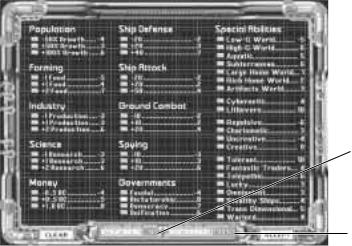
3. Beginning a New Game
pppppppppppppppppppppp
Custom
PICKS
SCORE
CUSTOMIZING YOUR RACE
The screen you use to design your custom race is the Race Customization screen. On this screen are three columns of options, 11 topics in all. Every one of the options included under these topics represents an advantage or disadvantage you can give your new race.
To name your custom race, click on the race name in the top middle of the
Race Customization screen to edit the name.
The last customized race created will be saved. Load that race by clicking on the ÒLast RaceÓ button instead of selecting a picture to use for your custom race.
The usual first step in creating a race is to click on the Clear button to erase all of the selections. This leaves you with a ÒGalactic NormalÓ raceÑ no advantages, no disadvantages, and no special characteristics. Notice that the two boxes at the bottom of the screen show that you have 10 Picks and 200% Score. What does that mean?
ÒPicksÓ is shorthand for Racial Ability And Characteristic Points, which wouldnÕt fit. You have 10 picks that you can use to develop your race. To the right of every option is that optionÕs Pick Modifier. If you choose that option for your race, you lose (if the modifier is positive) or gain (if itÕs negative) that many picks. Note that you can not choose disadvantageous options to gain more than 10 extra picks, and you are also not allowed to start a game with a negative pick total.
ÒScoreÓ is short for Score Multiplier As Determined By Picks. This is the percentage of your earned game score that will be awarded as your total score. Your picks total directly affects this. For example, if you have zero picks, your score is 100%; in this case, your earned score and your awarded score would be the same. If you choose not to use five of your picks, your score would be 150%; this would make your final awarded score 1.5 times your earned score.
Short descriptions of every optional characteristic follow. To pick or unpick a specific option, click on it. When youÕre satisfied with all your choices, click the Accept button to move on.
Colonial Production
Population growth modifiers affect the rate at which the population of every colony grows. This affects the base to which the effects of a planetÕs terrain and pollution are applied. Low population growth rates are usually the result of shorter life spans, slower biological processes, physical weakness, or some similarly inherent problem. Higher growth rates result from things like long life spans, strong immune systems, or general fecundity.
Farming production modifiers increase or decrease the amount of food each unit of population assigned to agriculture can grow. Like those for population growth, the farming modifiers affect the base that the effects of a planetÕs terrain and pollution are applied to. A farming bonus represents long familiarity with agriculture, resulting in effective techniques, while a penalty represents a simple lack of farming aptitude. (If the planet has a life-bearing environment, though, the penalty cannot go below 1 food per farmer.)
Industry modifiers affect the amount of production that each unit of population assigned to factory work can produce. Under no circumstances can industrial penalties reduce the capabilities of a population below 1 production per unit.
Science modifiers are applied to the amount of research that each scientist unit of a colonial population generates. Races with science bonuses are not necessarily more intelligent, but they are likely to be more inclined to rational investigation of the facts rather than superstitious beliefs. Science penalties cannot reduce the research abilities of a race below 1 research per unit of population assigned to science.
Money modifiers affect the tax burden (in BC) a population can withstand. Races with monetary bonuses have an instinctive grasp of commercial concepts, while races with penalties lack economic skills, interest, or avarice. Racial monetary penalties cannot reduce taxation possibilities below zero per population unit.
Game New a Beginning .3
3. Beginning a New Game
Combat and Espionage
Ship Defense modifiers change the chances of enemy fire hitting your ships during ship-to-ship combat. Races with bonuses in defense tend to be those with keen senses, giving them better luck at avoiding fire and misleading an attacker. Penalties, on the other hand, usually indicate that members of the race are physically slow or perhaps have difficulty visualizing complex three-dimensional motions.
Ship Attack modifiers improve or hurt the chances of your shipsÕ attacks hitting their intended targets. Racial bonuses are based on the ability to anticipate defendersÕ evasive tactics. Penalties might be the consequence of poor depth perception and tracking skillsÑor a simple unfamiliarity with aggressive behavior.
Ground Combat modifiers affect the combat effectiveness of troops engaged in planetary combat or ship boarding actions. Bonuses are generally representative of extraordinary strength, aggressiveness, and agility, while minuses indicate the lack thereof.
Spying modifiers affect the sabotage and espionage skills of a race. Races with specialized disguise abilities get bonuses, as well as those with a cultural bent toward deceit.
Governments
The type of government of each empire is determined at the beginning of the game and does not change, though research can lead to a more advanced form of the same government. There are four types of governments, each with its own strengths and weaknesses. Your government type affects what method of managing your empire is
most effective.
Feudal: A feudal government structure rests on the inherited titles and holdings of an elite class, somewhat as in medieval Europe. An emperor keeps the throne of a feudal government by balancing and subtly encouraging the rivalries between the more powerful members of this class.
•The morale of each planet under a Feudal government incurs a penalty of 20% until a Marine Barracks or Armor Barracks is built there. (Local troops are necessary to keep the serfs in line.)
•It takes 8 turns for a Feudal government to assimilate a unit of population in a conquered colony.
•Feudal populations will instantly assimilate if their colony is conquered by an opponent. (There is little loyalty to the central government, and local barons are always on the lookout for personal gain.)
•Due to the generally warlike nature of feudal governments, ship production costs are 2/3 normal.
•For the same reason, research is half the standard.
•If the capital of a Feudal empire is captured, the entire empire is thrown into a state of anarchy as rival claimants to the throne battle for supremacy. This period of anarchy lasts until a new capital is built. Morale suffers a 50% penalty during this period.
The advanced form of a Feudal government is Confederation. Confederated empires receive the following benefits in addition to the usual Feudal characteristics.
•Assimilation of conquered colonists takes only 4 turns.
•Ship production costs are reduced to 1/3 galactic normal.
•Confederation populations no longer instantly assimilate when captured.
Dictatorship: In a dictatorial government, one individual rules the entire empire without having to answer to anyone else. Orders and decisions are enforced through a ruthless and efficient organization, by any means necessary.
•Due to the increased internal security needed to prevent revolts, defensive spies gain a 10% bonus to every mission.
•The morale of each planet under a Dictatorial government suffers by 20% until a Marine Barracks or Armor Barracks is built there. (The presence of local troops is necessary to exert control.)
•It takes 8 turns for a Dictatorship to assimilate a unit of conquered population.
•If the capital of a Dictatorship is captured, a morale penalty of 35% is applied to all colonies until a new capital is built.
The advanced form of a Dictatorship is an Imperium. Imperium governments receive the following benefits in addition to the usual Dictatorial characteristics.
•Assimilation of conquered colonists takes only 4 turns.
•The Defensive Spy bonus is increased to 20%.
•Your command rating is increased by 50%.
Democracy: The ÒdemocracyÓ form of government is not a true democracy in the classical Greek style, but rather a ÒrepresentativeÓ democracy similar to that of the ancient United States of America. Control of the government is balanced between its multiple branches, and the population enjoys the most personal freedom allowed under any of the known forms of government.
Game New a Beginning .3
3. Beginning a New Game
•Because of the emphasis on personal freedom, privacy, and civil rights in a Democracy, defensive spies operate under a 10% penalty.
•On the other hand, greater personal liberty makes the people happier and more productive, giving a 50% bonus to both research and per capita (tax) income.
•It takes only 4 turns for a Democratic government to assimilate a unit of conquered population.
•Democracies are prohibited from eradicating conquered populations.
•If the capital of a Democratic government is captured, the entire citizenry suffers a period of uncertainty and chaos. This results in a 20% morale penalty until a new capital is built.
The advanced form of a Democracy is called a Federation. Federated governments receive the following benefits in addition to the usual Democratic characteristics.
•Assimilation of a unit of conquered population takes only 2 turns.
•The research and income bonus is increased to 75%.
Unification: The Unification form of government is available to those scant few races that can exist harmoniously together without jealousy, envy, or concern for individual advancement. Each individual works for the good of the community rather than the self. The analogy is often made between a Unified government and a colony of bees. Though correct in some ways, this is a misleading comparison. Unified populations are neither mindless nor uncreative; some unknown characteristic (many have suggested genetic uniformity) simply allows them to forego competition with one another.
•Since every individual works for the good of the whole, there can be no traitors. This gives Unification defensive spies a 15% bonus.
•Unification colonies do not have morale as such. They do, however, receive a 50% bonus to food and industry production due to the harmonious nature of their society. This functions like a morale bonus.
•All morale effects of buildings are ignored by Unification governments.
•The vast societal differences make it difficult for outsiders to join a Unified culture. It takes 20 turns for a Unified government to assimilate a unit of conquered population.
•The loss of the capital is irrelevant to a Unified race. Unified governments neither have nor need a capital.
The advanced form of Unification is Galactic Unification. Galactic Unification governments receive the following benefits in addition to the usual Unification characteristics.
•Assimilation time is reduced to 15 turns.
•The harmony production bonus (to food and industry) increases to 100%.
Special Abilities
In addition to the more run-of-the-mill racial modifiers, there are also a variety of special effects that make races more interesting to play. Some of these might seem to bend or break the galactic rules, but thatÕs part of the fun. Note that several of the special abilities are mutually exclusive, as they would contradict or negate the effect of one another.
Low-G World indicates that the race originally evolved on a home world with low gravity. This results in a population physically weaker than races from Normal-G or High-G worlds. Colonists from these races have difficulty adapting to intense gravitational fields, and can operate only on Low-G worlds without penalty. On Normal-G worlds, they suffer half the normal High-G penalty. Low-G troops suffer a 10% penalty
during ground combat. Low-G World and High-G World are mutually exclusive.
High-G World means that the race originates on a High-G planet. The members of such a population are considerably hardier and physically stronger than races from other types of world, and thus their colonists can operate in both High-G and Normal-G worlds without penalty.
In addition, High-G ground troops can sustain substantially more physical damage than other troops; they take 1 hit more than normal troops before being slain in ground combat. High-G World and Low-G World are mutually exclusive.
Aquatic races are spawned from ocean worlds, and therefore can more easily adapt to environments that are primarily water-based. For their purposes, Tundra and Swamp worlds count as Terran environments, and Ocean and Terran planets are considered Gaia class.
Subterranean races are semi-troglodyticÑadapted to living underground through the construction of expansive complexes of chambers and tunnels. As a result, a subterranean raceÕs maximum population on any planet is increased by that worldÕs size class (i.e., +2 for Tiny, +4 for Small, and so on up to +10 for Huge). Finally, due to the difficulty in navigating the underground labyrinths to dig them out, subterranean troops receive a 10% ground combat bonus when defending their colonies.
Game New a Beginning .3
3. Beginning a New Game
Large Home World gives a race the advantage of having some elbowroom early on. A large home world allows greater population growth, which leads to more food, quicker research, and faster production.
Rich Home World is another early advantage that can make a big difference. A mineral-rich home world means accelerated production, which is a very good thing.
Poor Home World is an early disadvantage that can make a big difference. A mineral-poor home world means slower production.
Artifacts World means that the raceÕs planet of origin was part of a great empire some time in the distant past. Artifacts from that time abound, giving the researchers a boost. Each unit of population assigned to science produces 5 research points instead of the usual 3.
Cybernetic races use mechanical appendages and artificial organs to sustain and augment their organic bodies. These populations consume minerals as well as foodÑone half unit of each. This cuts down on the necessity for farming, but causes an equivalent detriment to production. Their familiarity with machine interfaces allows these races to repair their ships completely after any combat. Even during combat, they fix armor and structural damage at 10% per round and systems damage at 5% per round. Cybernetic and Lithovore are mutually exclusive.
Lithovore describes those populations that have the ability to subsist on rock alone, without organic foodstuffs. These races can subsist on any planet simply by eating the minerals. This means farming is completely unnecessary (other than for profit) and freighters are unnecessary, except for transportation of colonists. Lithovore and Cybernetic are mutually exclusive.
Repulsive races find diplomacy frustrating, since all other races take an immediate dislike to the leader of a repulsive race. This severely limits the diplomatic options available. In addition, repulsive races assimilate conquered colonists into their population at only half the normal rate. Mercenary leaders are less likely to offer their services to a repulsive race, and they raise their hiring prices, as well. Repulsive and Charismatic are mutually exclusive.
Charismatic races make allies easily and quickly and can almost always talk themselves out of situations. This ability doubles the effects of all good diplomatic actions and halves that of negative ones. When proposing deals, charismatic races have a 50% bonus to the chance of acceptance. Since theyÕre so well admired, charismatic races assimilate conquered colonists easily into their population. Mercenary leaders are more likely to offer their services to these races, and they lower their hiring prices, too. Charismatic and Repulsive are
mutually exclusive.
Uncreative describes those races that have great difficulty conceiving new ideas for applications of basic research. These racesÕ researchers and engineers only recognize the possibility of one technology associated with any field of scientific endeavor. The Uncreative and Creative options are mutually exclusive.
Creative races have little difficulty seeing the more unusual possibilities inherent in a field of study. As a result, these races are able to discover all of the technological applications appropriate to a field of research. No race can be both Creative and Uncreative.
Tolerant means that a race is practically immune to extreme environments. Typically, these races have strong regenerative properties or a metabolism quite unlike that of the average humanoid. Races that are tolerant can use 25% more of a planetÕs surface for habitation, living in places no other race would dare and boosting the planetÕs maximum potential population. Thus, for example, while a typical race could live on 25% of a Barren planet, a Tolerant race could use 50% of the same planet. Tolerant races also suffer no harm from pollution and need not spend production resources cleaning it up.
Fantastic Traders possess a keen understanding of economics and deal making. They receive a 25% bonus to the profit taken from trade treaties, plus 1 BC (instead of the usual half) for every surplus unit of food generated. On top of that, traders get a 50% bonus to all income derived from producing trade goods.
Telepathic races are capable of reading the minds of other beings, allowing them to exactly isolate the motivations of anyone with whom they are attempting to negotiate. As a result, telepathic races gain a 25% bonus when conducting diplomatic negotiations with other races. Furthermore, telepaths in orbit around an undefended planet can directly affect the thoughts of the besieged population. Highly trained telepaths are assigned as crew on each ship of size Large or bigger. These telepaths can break down the resistance of the enemy population and conquer the colony without bloodshed. (Of course, this doesnÕt work on Telepathic races.) Telepathic races instantly assimilate conquered populations into their empire. Also, telepathic spies are extremely adept and get a 10% bonus, regardless of their mission. Unlike everyone else, Telepathic races can immediately use ships captured in combat.
Lucky refers to those races who, somehow, never suffer from random galactic disasters. Lucky races also benefit from more than their fair share of good random events. Space monsters and even the Antarans tend to overlook the colonies of lucky races.
Game New a Beginning .3
3. Beginning a New Game
Omniscient races are those who have some (usually secret) method of gleaning information from the entire galaxy without ever physically leaving home. Thus, these races know the make-up of every star system and planet throughout the entire galaxy at the start of the game. They see the whereabouts, movements, and destinations of enemy fleets, regardless of any stealth abilities or technologies.
Stealthy Ships: Some races have found ways to completely mask their ships from long-range sensors. This ability does not have any effect during combat, but it prevents a scanning system from detecting the approaching fleet.
Trans-Dimensional beings are capable of folding the fabric of space with their minds. This allows them to travel without the aid of FTL drives (though they still must have ships in which to travel). Those ships with FTL capability add 2 to the speed at which they travel the interstellar distances and 4 to their combat speed. Trans-Dimensional races are also not affected by Hyperspace Fluxes.
Warlord races evolve from cultures with a high regard for all things military or warlike. All ship crews of a warlord race begin at one level of experience higher than normal, and these crews have the potential to eventually reach Ultra-elite status. Ground defendersÑMarines and ArmorÑare produced at double the normal rate, and warlord barracks can support twice the usual number of ground troops. Mercenary leaders working in the hire of a Warlord race are inspired by example, and have effects as if they were 1 experience level higher than they actually are. Every colony you control contributes 2 points to your Command Rating.
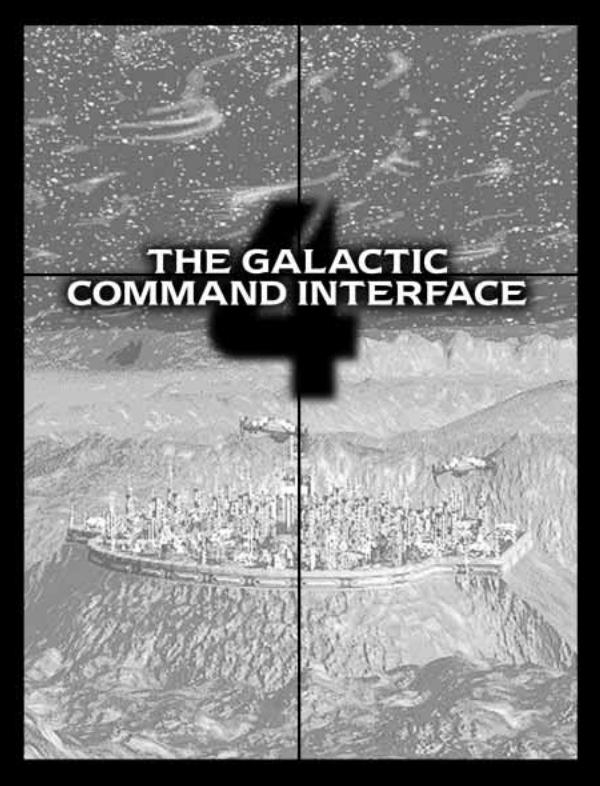
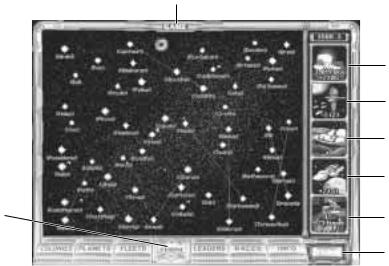
4. The Galactic Command Interface
GAME MENU
|
TREASURY |
|
COMMAND |
|
FOOD |
|
FREIGHTERS |
ZOOM |
RESEARCH |
|
END TURN |
|
THE WHOLE GALAXY |
|
When the galaxy has been generated and the game begins, the first thing |
|
you see is the Galaxy Map. This is the central interface from which you |
|
conduct your entire imperial campaign. There are several useful |
|
components on this interfaceÑincluding the map itself. LetÕs take them |
|
one at a time. |
HELP AND QUIT
Before you start, itÕs nice to know that thereÕs a Help system in place for novice galactic emperors. When the mouse pointer is on one of the active areas of a screen, window, panel, or whatever, you can right-click to call up basic information about that active area. (Not all areas have help, but most do.)
When youÕre done reading, click on the Close button to clear the Help window away.
If at any time you wish to quit Master of Orion II quickly and return to the operating system, use the keyboard shortcut a+ Q.
ONE VERSATILE MAP
The main portion of the screen is a map of your entire galaxy.
Stars: Every star system you can visit is shown on the map in the color of its primary star. (Refer to Star Color, in the Star Systems section, for the details on the different types and colors of star.) You can click on any star you have already visited to open up the System window. We explain the uses of this window shortly, in The System Window.
If you look closely, youÕll notice that your home system is labeled by name and in your imperial color. After you have explored other systems, their labels show up. Systems colonized by any race (including yours) are labeled in that empireÕs color.
To quickly find the distance between two star systems, use the keyboard shortcut 9. YouÕll need to click on the first star, then move the mouse cursor over any other star to see the distance (in parcsecs) between them.
Some problematic interstellar stuff also appears on the map:
Nebulae: These are huge interstellar clouds of tiny particles. Their brightness and colors are normally caused by ionizing radiation from some nearby source. Though this wispy ionized plasma is thin by terrestrial standards, compared to the vacuum of space, itÕs extremely dense. Ships traveling through a nebula are reduced in speed to 1 parsec per turn. More importantly, the fierce ionization prevents deflector shields from functioning without Hard Shields technology. Planets found inside nebulas are often mineral rich.
Black Holes: When enough mass accumulates in a small enough volume (most commonly at the centers of galaxies and when giant stars collapse), the gravitational field becomes so powerful that even light cannot escape. A gravity well of this incredible magnitude is known as a black hole. Black holes are by their nature invisible (except in some portions of the X-ray spectrum), so their locations are represented on the map by dark whirlpools. The effects of such an awesome force extend even into the hyperspace through which your ships travel. No ship can safely pass within 2 parsecs of a black hole (unless the ship contains an officer with the Navigator skill).
Interface Command Galactic The .4
4. The Galactic Command Interface
At the beginning of most campaigns, thatÕs all you see in the galaxy, but as you explore your stellar neighborhood, other things gradually show up on the map. These include:
Fleets: Any ship or group of ships you have control of is indicated on the map by a tiny ship icon in your imperial color. If you somehow know the current location of another raceÕs fleet, itÕs shown, too, but in that empireÕs color. You can click on any displayed fleet to get information about it orÑin the case of your ships at certain timesÑgive orders. The details are below, in The Fleet Window.
The location of each icon tells you something about it. If itÕs between star systems, then it is en route to somewhere. Icons sitting above and to the right of a star are in orbit around a planet in that system. Tiny ships above and to the left of a star have been given orders to leave that system for another and are just about to go.
Monsters: From time to time, explorers discover immense, hostile creatures living in a star system. At other times, similar monsters ÒinvadeÓ the galaxy. The space monsters, when their location is known, appear on the map. For tracking and combat purposes, theyÕre treated as fleets.
Travel Lines: When any of your fleets are between stars, the space between the ships and their destination is marked by a solid line. Near the fleet is a tiny numberÑthe remaining flight time. If you somehow know the destination of another raceÕs fleet, that is displayed as well.
Wormholes: These bizarre spatial anomalies are thought to be created when two black holes collide at unimaginably high velocity and turn each other inside-out. Somehow, the interaction of the singularity regions ÒpinchesÓ two distant points in hyperspace together. Regardless of the cause, the effect is clear; any ship can travel from one end of a stable wormhole to the other in only 1 turn, no matter what the distance. Wormholes are marked on the map as grey lines connecting two points.
Structures: Scientific advancement eventually leads to the possibility of controlling some of the more esoteric forces of the galaxy. When an empire builds a Dimensional Portal or an Artemis System Net (see Research and Development for details), it shows up on the map near the system in which it was built.
Along the bottom of the Galaxy Map is a button bar. All of these buttons except the ones in the center open windows in which you manage some aspect of your empire. ThatÕs why theyÕre called the Management buttons. ThereÕs also an important button down in the lower right-hand corner. WeÕll cover the two non-management buttons here and the rest a little further on.
